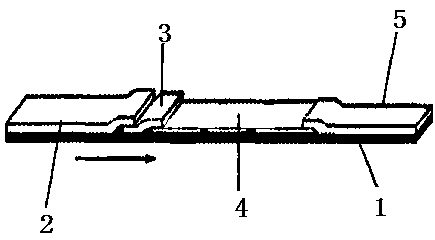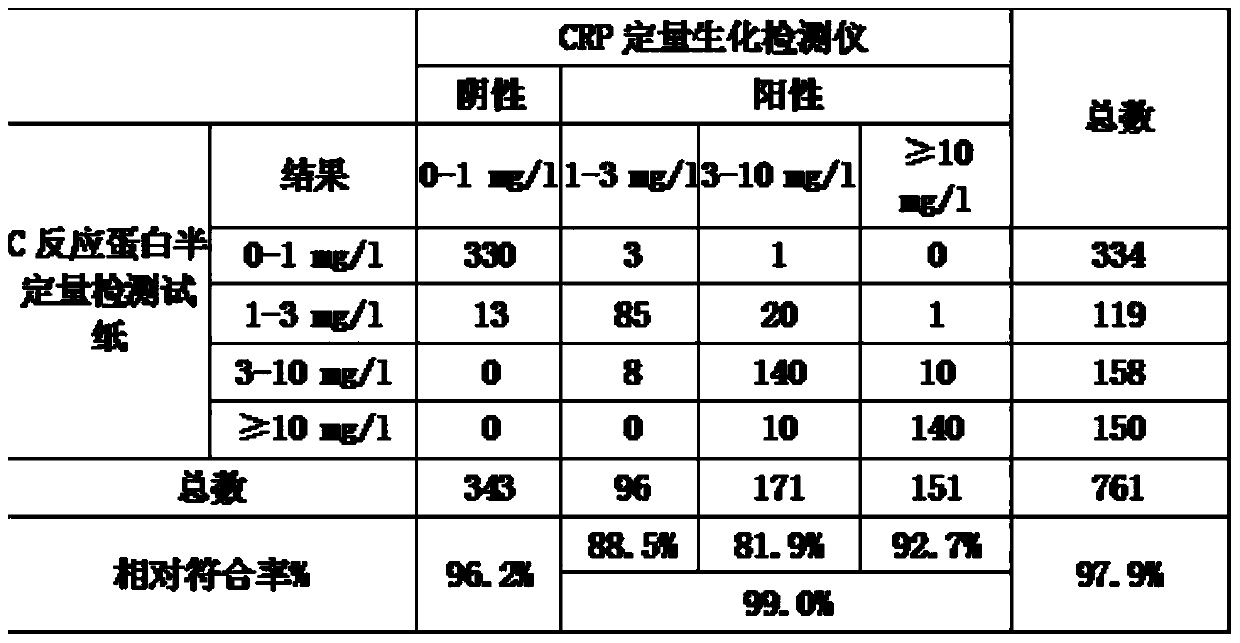C-reactive protein (CRP) semi-quantitative detection reagent and test paper using reagent
A semi-quantitative detection and reaction protein technology, applied in the field of molecular biology, can solve the problems of inapplicability to small-scale hospitals, long detection time, etc., and achieve the effects of reducing detection application cost, sensitive response, and wide application range.
- Summary
- Abstract
- Description
- Claims
- Application Information
AI Technical Summary
Problems solved by technology
Method used
Image
Examples
Embodiment 1
[0053] 1. Dilute the sample (serum or plasma) with sample diluent at 1:200;
[0054] 2. Take 40 μl of the diluted sample and add it dropwise to the sample pad on the test paper disclosed by the present invention;
[0055] 3. Stand at room temperature for 10 minutes;
[0056] 4. After 10 minutes, judge the sample test result according to the quality control line.
[0057] 1. Preparation of colloidal gold
[0058] Raw materials:
[0059] 2%HAucl 4 (1g HAucl 4 dissolved in 50ml deionized water)
[0060] 1% trisodium citrate solution (1g trisodium citrate dihydrate dissolved in 100ml deionized water)
[0061] method:
[0062] 1. Take 198ml ddH 2 O (double distilled water) in the Erlenmeyer flask, add 2ml 2% HAuCL 4 solution, mix well.
[0063] 2. Place the Erlenmeyer flask on top and heat to boil.
[0064] 3. Quickly add 5ml 1% trisodium citrate solution at one time and continue to boil.
[0065] 4. Observe the color change of the solution, from light yellow→black→purp...
Embodiment 2
[0102] The difference between embodiment 2 and embodiment 1 only lies in:
[0103] 2. Antibody labeling (gold standard solution, follow the steps below to configure step by step)
[0104] 4. Add 5 μg CRPⅡ and 10 μg rabbit IgG respectively, mix immediately after adding the antibody, and let stand for 15 minutes
[0105] 7. Finally, resuspend with 1ml gold resuspension solution pH74, 20mM Tris-Hcl (containing 0.1% casein, 5% sucrose, 1% BSA, 0.3% tween20; 0.05% NaN 3 ) to resuspend.
[0106] 3. Scribe and touch gold
[0107] dash:
[0108]1. Dilute the CRPⅠ antibody to 0.1mg / ml, and the dilution solvent is PBS (10nM-50mM, in terms of phosphate concentration, the preferred concentration here is 10mM), to obtain the reagent for marking with the CRPⅠ antibody for coating.
[0109] GAR (goat anti rabbit) antibody was diluted to 0.5mg / ml and 0.1mg / ml respectively, and the dilution solvent was PBS (10-50mM, in terms of phosphate concentration, the preferred concentration here was ...
Embodiment 3
[0114] The difference between embodiment 3 and embodiment 1 only lies in:
[0115] 2. Antibody labeling (gold standard solution, follow the steps below to configure step by step)
[0116] 4. Add 1 μg CRPⅡ and 15 μg rabbit IgG respectively, mix immediately after adding the antibody, and let stand for 15 minutes
[0117] 7. Finally, resuspend with 1ml gold resuspension solution pH10, 20mM Tris-Hcl (containing 0.5% casein, 15% sucrose, 3% BSA, 0.15% tween20; 0.05% NaN 3 ) to resuspend.
[0118] 3. Scribe and touch gold
[0119] dash:
[0120] 1. Dilute the CRPⅠ antibody to 1.5mg / ml, and the dilution solvent is PBS (10nM-50mM, based on the concentration of phosphate, the preferred concentration here is 50mM), to obtain the reagent for marking with the CRPⅠ antibody for coating.
[0121] GAR (goat anti rabbit) antibody was diluted to 0.1mg / ml and 0.5mg / ml respectively, and the dilution solvent was PBS (10-50mM, in terms of phosphate concentration, the preferred concentration he...
PUM
 Login to View More
Login to View More Abstract
Description
Claims
Application Information
 Login to View More
Login to View More - R&D
- Intellectual Property
- Life Sciences
- Materials
- Tech Scout
- Unparalleled Data Quality
- Higher Quality Content
- 60% Fewer Hallucinations
Browse by: Latest US Patents, China's latest patents, Technical Efficacy Thesaurus, Application Domain, Technology Topic, Popular Technical Reports.
© 2025 PatSnap. All rights reserved.Legal|Privacy policy|Modern Slavery Act Transparency Statement|Sitemap|About US| Contact US: help@patsnap.com



